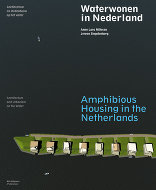Publikation
Amphibious Housing in the Netherlands
Architecture and Urbanism on the Water
ISBN: 9789056627805
Sprache: Englisch, Holländisch
Publikationsdatum: 2011
Umfang: 128 S.,
Format: Paperback, 23 x 28 cm
Amphibious Housing in the Netherlands outlines the trends and experiments in the realm of architecture on and in close proximity to water. It is impossible to imagine our spatial and urban planning without water, and this book reveals what is happening in the realm of amphibious housing and how that is progressing. As an encore, the book presents an initial proposal for how this might be achieved more efficiently, more astutely and on a larger scale in the future. The will be available in bookstores from 11 April onwards.
People have been living on and alongside water for centuries, and the Netherlands, with its polders, dikes and waterways, boasts a unique tradition in this regard. The consequences of climate change and urban expansion for this densely populated delta are great, which is a driving force for experiments with innovative forms of housing and organizational principles. Various housing types have been devised for this watery environment over recent years: floating dwellings, amphibious dwellings, pile dwellings, mound dwellings and dike dwellings. The first pilot schemes have already been realized, but now those clusters of dwellings will grow into complete amphibious districts with a dedicated infrastructure, mains and services. This challenges urban and rural planners, developers, policy-makers, designers and other experts to integrate water in their visions for housing and urban development. How do we design a district that amounts to more than a „normal“ land-based neighbour-hood with an abundance of water and is more than a colony of houseboats with limited amenities? How can we best manage accessibility, routing, the quality of public space and privacy? What new principles does amphibious urbanism bring into play?
People have been living on and alongside water for centuries, and the Netherlands, with its polders, dikes and waterways, boasts a unique tradition in this regard. The consequences of climate change and urban expansion for this densely populated delta are great, which is a driving force for experiments with innovative forms of housing and organizational principles. Various housing types have been devised for this watery environment over recent years: floating dwellings, amphibious dwellings, pile dwellings, mound dwellings and dike dwellings. The first pilot schemes have already been realized, but now those clusters of dwellings will grow into complete amphibious districts with a dedicated infrastructure, mains and services. This challenges urban and rural planners, developers, policy-makers, designers and other experts to integrate water in their visions for housing and urban development. How do we design a district that amounts to more than a „normal“ land-based neighbour-hood with an abundance of water and is more than a colony of houseboats with limited amenities? How can we best manage accessibility, routing, the quality of public space and privacy? What new principles does amphibious urbanism bring into play?
Weiterführende Links:
NAI Publishers







